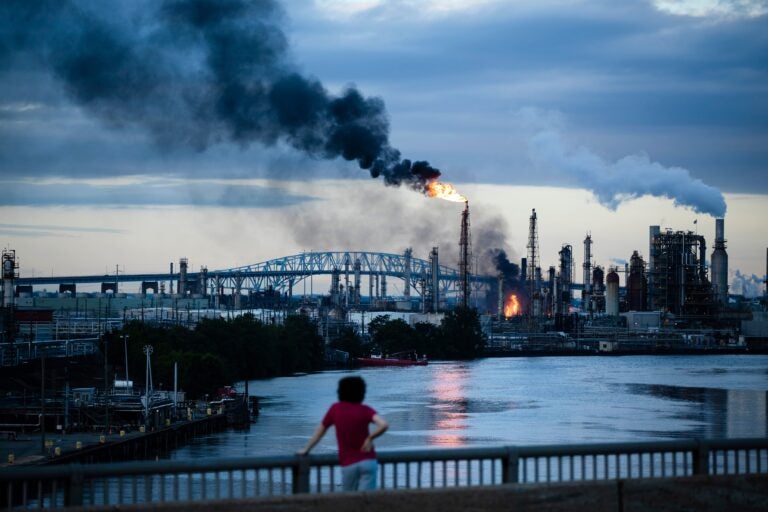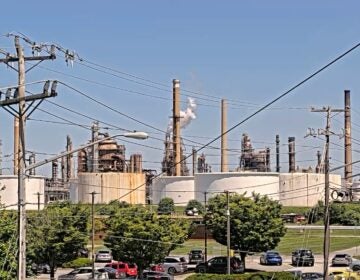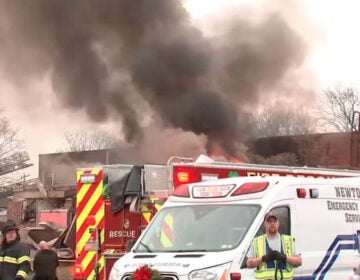‘The stuff of nightmares’: Philly nonprofit sues EPA over deadly chemical used at refineries
Three nonprofits hope to force the federal government to regulate hydrogen fluoride more strictly. The chemical is still used at a Delaware County refinery.
Listen 1:25
File: Flames and smoke emerge from the Philadelphia Energy Solutions Refining Complex in Philadelphia, June 21, 2019. Hydrogen fluoride, which can travel for miles, was released, but most was diverted before any serious impacts occurred. In July 2025, three environmental groups sued the federal government in the hopes of further regulating the chemical. (AP Photo/Matt Rourke)
This story is part of the WHYY News Climate Desk, bringing you news and solutions for our changing region.
From the Poconos to the Jersey Shore to the mouth of the Delaware Bay, what do you want to know about climate change? What would you like us to cover? Get in touch.
A deadly chemical used at a refinery south of Philadelphia and dozens of others across the country poses an “unreasonable risk” to human health and the environment, according to a group of environmental nonprofits.
The Philadelphia-based Clean Air Council, California-based Communities for a Better Environment and the Natural Resources Defense Council sued the federal government earlier this month, urging the U.S. Environmental Protection Agency to put new regulations in place to keep communities safer from dangerous hydrogen fluoride.
“Honestly, this chemical … is the stuff of nightmares,” said Annie Fox, a staff attorney at the Clean Air Council.
Hydrogen fluoride is used as a catalyst in the blending process to make cleaner-burning high-octane gasoline at roughly 40 refineries across the country, according to the lawsuit. It’s also used to manufacture refrigerants, herbicides and pharmaceuticals.
The chemical can travel for miles when it’s released and can be deadly when inhaled or splashed on the skin at high levels. It can cause deep burns and affect major internal organs. Some refineries use sulfuric acid — which can still cause burns but does not pose as great a risk to surrounding communities, according to the federal Chemical Safety Board — for the same purpose.
The 2019 explosion and fire at the Philadelphia Energy Solutions refinery in South Philly did release some hydrogen fluoride, but most of it was diverted before any serious impacts occurred. The incident, however, raised awareness of hydrogen fluoride’s deadly potential in the region. The refinery has since shut down and been dismantled. The land is being converted to a warehouse distribution center.
The lawsuit claims the risk of hydrogen fluoride leaks from refineries is “substantial, foreseeable, and growing.” The groups petitioned the EPA earlier this year to ban refineries’ use of the chemical, citing the Philadelphia Energy Solutions refinery fire and ongoing risks from Monroe Energy’s refinery in Trainer, Pennsylvania.
The EPA rejected this petition.
Now, the nonprofits are asking a federal judge in California to force the EPA to eliminate the “unreasonable” risk they say refineries’ use of the chemical poses.
“If we are successful, we will never know the impact that we had, because a major disaster will have been prevented before it could happen,” Fox said.
The EPA declined to comment on the lawsuit, saying the agency does not comment on pending litigation.
‘Worst-case scenario’ at Delco refinery in Trainer, Pa. could expose nearly 2 million people
Monroe Energy’s Trainer Refinery, in Delaware County, uses hydrogen fluoride in its alkylation unit.
A “worst-case” scenario leak of hydrogen fluoride from the refinery could travel 17 miles, potentially exposing 1.9 million people who live in that radius, according to a 2022 filing the refinery made with the EPA which is cited in the lawsuit. The agency requires facilities that handle a certain amount of hydrogen fluoride to submit a risk management plan.
Earlier this month, a power outage at the refinery led to a flaring episode that was blamed for causing an odor in neighboring Delaware. Routine pollution incidents like this raise concerns that the Trainer refinery could experience some kind of accident involving hydrogen fluoride, Fox said.
“They’ve been having actually a number of incidents lately, which just highlights how the equipment is aging and becoming less reliable,” she said.
But the refinery operator, Monroe Energy, refutes this. The company considers safety of “paramount importance,” said spokesperson Adam Gattuso.

Monroe Energy has invested over $2 billion in equipment upgrades since restarting the refinery over a decade ago and employs a range of safety measures in its alkylation unit. These include cameras, laser sensors, paint that changes color in the presence of hydrogen fluoride and monthly inspections of thousands of points in the refinery’s equipment.
The refinery also has a “recently upgraded” system that diverts hydrogen fluoride to a safe location in an emergency, Gattuso said.
A nearby refinery in Paulsboro, New Jersey, handled hydrogen fluoride as recently as 2020, according to EPA records. The refinery’s owner, PBF Energy, did not respond to questions about whether the chemical is still used on site.
The American Fuel and Petrochemical Manufacturers, a trade group representing refineries, said hydrogen fluoride is the “most efficient fuel alkylation catalyst, requiring less volume of acid and fewer tank truck shipments,” which translates to lower costs for consumers.
The group said there are several different systems and strategies refineries employ to use hydrogen fluoride safely. The group said the chance of a life-threatening hydrogen fluoride injury for people who live near refineries is lower than the chance of being struck by lightning.
A ‘wake-up call’ from the PES refinery explosion
The 2019 fire and series of explosions at the now-demolished Philadelphia Energy Solutions refinery was viewed as a near-miss that could have exposed nearby communities to hydrogen fluoride.
A leak from a corroded pipe elbow in the refinery’s alkylation unit released a cloud of flammable propane and a smaller amount of hydrogen fluoride, according to the U.S. Chemical Safety Board, an independent federal agency that investigates industrial accidents.
Minutes later, the chemical cloud ignited. An employee quickly activated a system that drained the remaining roughly 300,000 pounds of hydrogen fluoride from the alkylation unit into a separate tank, away from the fire.
“We were very lucky,” Fox said. “If they hadn’t responded quickly enough, there could have been a massive release.”
Ultimately, more than 5,000 pounds of the deadly chemical leaked. Most was released to the atmosphere, and a fraction was contained by a water spray system that a refinery worker turned on manually 40 minutes into the incident, according to the Chemical Safety Board. The water spray system was damaged during the incident, preventing it from being activated remotely.
“The local community in Philadelphia fortunately was not seriously harmed, but given the refinery’s location, it could have been much worse,” Steve Owens, then-interim executive authority of the Chemical Safety Board, said at the time. “This incident should be a wake-up call to industry to prevent a similar event from occurring in the future.”
After its investigation into the cause of the fire, the Chemical Safety Board recommended the EPA prioritize inspections of refinery alkylation units that use hydrogen fluoride and require refineries to evaluate every five years whether they could use a safer alternative to the chemical. The board also urged the EPA to launch a multistep process for determining whether hydrogen fluoride poses an “unreasonable risk” and potentially increasing regulation of the chemical to reduce this risk.
The Trump administration proposed defunding and shutting down the Chemical Safety Board in its budget plan last month. A draft appropriations bill released by a House committee would maintain the agency’s existence, but cut its budget nearly in half. A Senate committee is expected to release its version of the bill later this week.
The EPA’s role in regulating risks from hydrogen fluoride
In 2023, the EPA seemingly followed the Chemical Safety Board’s recommendation and announced an enforcement initiative focused on inspecting and addressing noncompliance at facilities using hydrogen fluoride and another hazardous chemical. The agency cited “recent incidents involving the release or potential release of highly toxic hydrogen fluoride.”
Then last year, the EPA asked chemical manufacturers for more information on the health risks of hydrogen fluoride. This is the first step in the multistep process the Chemical Safety Board recommended the EPA undertake after the PES fire. It can lead to more regulation of the chemical, if the EPA decides to prioritize the chemical for risk evaluation, then determines the chemical poses an “unreasonable risk” that must be eliminated.
The group of environmental nonprofits is trying to advance this process.
They filed a petition in February urging the EPA to ban use of hydrogen fluoride in petroleum refining, citing more than two dozen documented leaks of the chemical from refineries in recent decades. They also pointed to aging refinery equipment, increasing exposure of refineries to extreme weather due to climate change and the availability of safer alternatives to the chemical.
But this May, the agency rejected the petition, calling it “deficient.” The nonprofits described “catastrophic, accidental, and worst-case scenarios” involving the chemical, which do not lead to “regular and predictable exposures,” EPA officials said. The agency said the facts the nonprofits presented did not establish an “unreasonable risk.”
Now, the nonprofits are asking a judge to overrule this. They want the EPA to publish a proposed rule regulating the chemical further within a year of a court’s ruling, then finalize that rule the following year.

Get daily updates from WHYY News!
WHYY is your source for fact-based, in-depth journalism and information. As a nonprofit organization, we rely on financial support from readers like you. Please give today.








